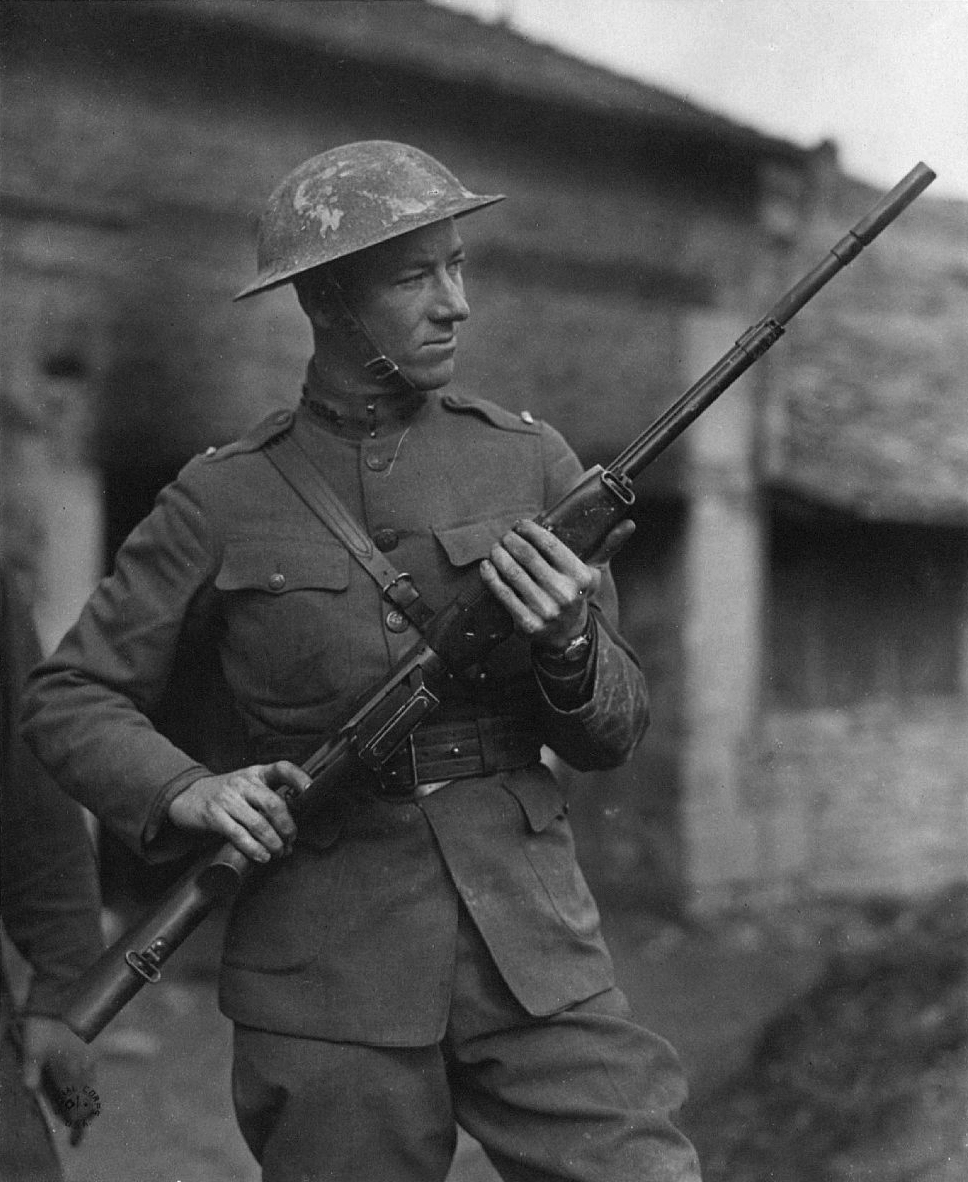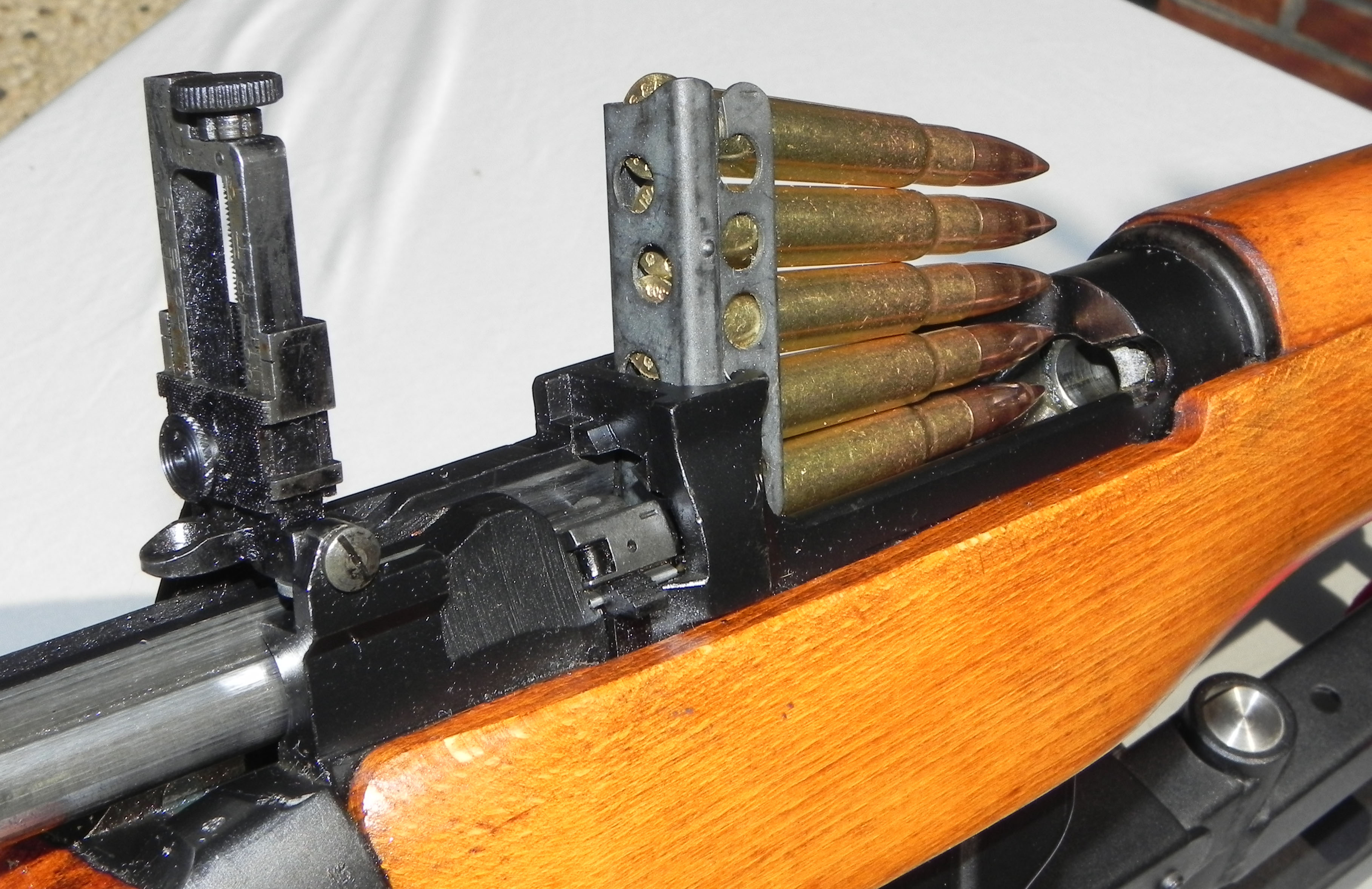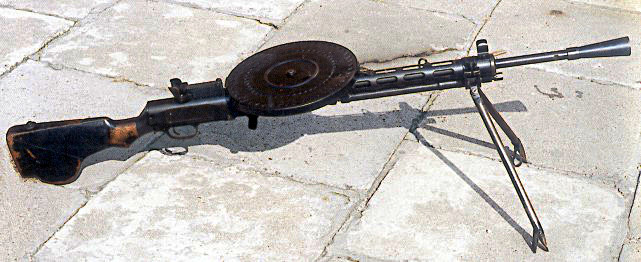|
Fedorov Avtomat
The Fedorov Avtomat (also anglicized as Federov, ) or FA is a select-fire infantry rifle and also one of the world's first operational automatic rifles, designed by Vladimir Grigoryevich Fyodorov in 1915 and produced in the Russian Empire and later in the Russian Soviet Federative Socialist Republic. A total of 3,200 Fedorov rifles were manufactured between 1915 and 1924 in the city of Kovrov; the vast majority of them were made after 1920. The weapon saw limited combat in World War I, but was used more substantially in the Russian Civil War and in the Winter War. Some consider it to be an "early predecessor" or "ancestor" of the modern assault rifle. Design and development The Fedorov Avtomat is a short-recoil operated, locked-breech weapon which fires from a closed bolt. The bolt locking is achieved by a pair of symmetrical plates mounted to either side of the breech and held in place by a sheet metal cover, each with two lugs, one square and one round, mounted at either sid ... [...More Info...] [...Related Items...] OR: [Wikipedia] [Google] [Baidu] |
Automatic Rifle
An automatic rifle is a type of autoloading rifle that is capable of fully automatic fire. Automatic rifles are generally select-fire weapons capable of firing in semi-automatic and automatic firing modes (some automatic rifles are capable of burst-fire as well). Automatic rifles are distinguished from semi-automatic rifles in their ability to fire more than one shot in succession once the trigger is pulled. Most automatic rifles are further subcategorized as battle rifles or assault rifles. History Mannlicher In 1885 Ferdinand Mannlicher made an experimental self-loader based on work begun in 1883 in both semi-automatic and fully automatic modes. It was an impractical failure due to fouling by its black powder ammunition, but it influenced later designs. Furthermore, Mannlicher produced smokeless powder automatic rifles from the early 1890s onwards until his death in 1904. Cei-Rigotti One of the world's first automatic rifles was the Italian Cei-Rigotti. Introduced in ... [...More Info...] [...Related Items...] OR: [Wikipedia] [Google] [Baidu] |
Vladimir Grigoryevich Fyodorov
Vladimir Grigoryevich Fyodorov (russian: Владимир Григорьевич Фёдоров) (3 (15) May, 1874, Saint Petersburg – 19 September 1966, Moscow) was a Russian and Soviet scientist, weapons designer, professor, lieutenant general of the Soviet technical-engineering service and a founder of the Soviet school of automatic small arms. In 1900 Vladimir Fyodorov graduated from Mikhailovskaya Artillery Academy and was transferred to the artillery committee of the Chief Artillery Directorate (Главное артиллерийское управление). He designed a number of automatic rifles: one chambered in 7.62 mm (1912), another in 6.5 mm for a cartridge of his own design (1913), and one of the first prototype assault rifles in the world: the Avtomat Fyodorova (1916), which was originally designed to fire a shortened Arisaka 6.5mm rifle cartridge, but saw service firing the full-sized 6.5 mm Arisaka rifle cartridge due to reliability issues in ... [...More Info...] [...Related Items...] OR: [Wikipedia] [Google] [Baidu] |
Mosin–Nagant
The Mosin–Nagant is a five-shot, bolt-action, internal magazine–fed military rifle. Known officially as the 3-line rifle M1891 and informally in Russia and former Soviet Union as Mosin's rifle ( ru , винтовка Мосина, ISO 9: ), it is primarily found chambered for its original 7.62×54mmR cartridge. Developed from 1882 to 1891, it was used by the armed forces of the Russian Empire, the Soviet Union and various other states. It is one of the most mass-produced military bolt-action rifles in history, with over 37 million units produced since 1891. In spite of its age, it has been used in various conflicts around the world up to the present day. History Initial design and tests During the Russo-Ottoman War of 1877–1878, Russian troops armed mostly with Berdan single-shot rifles suffered heavy casualties against Turkish troops equipped with Winchester repeating rifles, particularly at the bloody Siege of Pleven. This showed Russian commanders the need to mode ... [...More Info...] [...Related Items...] OR: [Wikipedia] [Google] [Baidu] |
Guns (magazine)
''Guns'' is a magazine dedicated to firearms, hunting, competition shooting, reloading, and other shooting-related activities in the United States. First published in 1955, it is one of the oldest periodicals about firearms in continuous publication in the United States The magazine primarily offers reviews on guns, ammunition, and shooting gear; as well as gunsmithing tips, historical articles, gun collecting, self-defense, and alerts on gun rights The right to keep and bear arms (often referred to as the right to bear arms) is a right for people to possess weapons (arms) for the preservation of life, liberty, and property. The purpose of gun rights is for self-defense, including securi .... In addition to those departments, each issue contains a few featured articles and personality profiles of people in the firearms industry as well as press releases of new products. References {{Reflist External links Official website Monthly magazines published in the United States ... [...More Info...] [...Related Items...] OR: [Wikipedia] [Google] [Baidu] |
Arisaka
The Arisaka rifle ( ja, 有坂銃, Arisaka-jū) is a family of Japanese military bolt-action service rifles, which were produced and used since approximately 1897, when it replaced the Murata rifle (, ) family, until the end of World War II in 1945. The most common models include the Type 38 chambered for the 6.5×50mmSR Type 38 cartridge, and the Type 99 chambered for the 7.7×58mm Type 99 cartridge, which is comparable in power to a modern .308 Winchester round. History The Arisaka rifle was designed by Colonel Arisaka Nariakira (; 1852–1915), who was later promoted to lieutenant general and also received the title of baron from Emperor Meiji, in 1907. Over the course of various wars several productions runs and variants were made, including the transition from the 6.5mm Type 38 cartridge to the larger 7.7mm Type 99, and the introduction of a paratrooper rifle that could be disassembled into two major parts for airborne operations. Tests on samples of Arisaka rifles con ... [...More Info...] [...Related Items...] OR: [Wikipedia] [Google] [Baidu] |
Stripper Clips
A stripper clip (also known as a charger or charger clip, especially in British and in Commonwealth military vocabulary) is a speedloader that holds several cartridges (usually between 5 and 10) together in a single unit for easier and faster loading of a firearm magazine. Stripper clips were originally employed in infantry bolt-action rifles, such as the Russian Mosin–Nagant, the British Lee–Enfield, and the German Mauser Model 1889, Gewehr 98 and its variant the Karabiner 98k, the related US M1903 Springfield, M1917, Swiss K31 and many others. Stripper clips were also employed in newer, semi-automatic rifles with internal box magazines, such as the Soviet SKS, and the Egyptian Hakim Rifle. Stripper clips differ from ''en bloc'' clips in that they are not designed to be inserted into the weapon itself, but only to load it or its magazine. After the magazine is loaded, the stripper clip is removed and set aside for reloading, or simply discarded during combat. Generally ... [...More Info...] [...Related Items...] OR: [Wikipedia] [Google] [Baidu] |
Chauchat
The Chauchat ("show-sha", ) was the standard light machine gun or "machine rifle" of the French Army during World War I (1914–18). Its official designation was "Fusil Mitrailleur Modele 1915 CSRG" ("Machine Rifle Model 1915 CSRG"). Beginning in June 1916, it was placed into regular service with French infantry, where the troops called it the FM Chauchat, after Colonel Louis Chauchat, the main contributor to its design. The Chauchat in 8mm Lebel was also extensively used in 1917–18 by the American Expeditionary Forces (A.E.F.), where it was officially designated as the "Automatic Rifle, Model 1915 (Chauchat)". A total of 262,000 Chauchats were manufactured between December 1915 and November 1918, including 244,000 chambered for the 8mm Lebel service cartridge, making it the most widely manufactured automatic weapon of World War I. The armies of eight other nations—Belgium, Finland, Greece, Italy, Poland, Romania, Russia, and Serbia—also used the Chauchat machine rifle in fa ... [...More Info...] [...Related Items...] OR: [Wikipedia] [Google] [Baidu] |
Mont-Saint-Éloi
Mont-Saint-Éloi (; vls, Sint-Elooisberg) is a commune in the Pas-de-Calais department in the Hauts-de-France region of France. Geography Mont-Saint-Éloi is situated northwest of Arras, at the junction of the D341 and the D49 roads, on the banks of the river Scarpe. Population Places of interest * The church of St. Joseph, dating from the sixteenth century. * The Commonwealth War Graves Commission cemetery. * The eighteenth-century chateau d’Écoivres. * Remains of an abbey church, destroyed in 1783. * Two menhirs, known as the ''Twin Stones''. Mont Saint-Éloi Abbey The monastery was founded in the 7th century by Vindicianus, bishop of Arras and devotee of Saint Eligius. The bishop was buried in the nearby Bois d'Ecoives, but his relics were subsequently removed to the Abbey Church of St. Joseph, which was enlarged in the 11th century. The abbey adopted the Rule of Saint Augustine, and was the motherhouse of St. Botolph's Priory in Colchester. The medieval buildings we ... [...More Info...] [...Related Items...] OR: [Wikipedia] [Google] [Baidu] |
Military Observer
A military, also known collectively as armed forces, is a heavily armed, highly organized force primarily intended for warfare. It is typically authorized and maintained by a sovereign state, with its members identifiable by their distinct military uniform. It may consist of one or more military branches such as an army, navy, air force, space force, marines, or coast guard. The main task of the military is usually defined as defence of the state and its interests against external armed threats. In broad usage, the terms ''armed forces'' and ''military'' are often treated as synonymous, although in technical usage a distinction is sometimes made in which a country's armed forces may include both its military and other paramilitary forces. There are various forms of irregular military forces, not belonging to a recognized state; though they share many attributes with regular military forces, they are less often referred to as simply ''military''. A nation's military may f ... [...More Info...] [...Related Items...] OR: [Wikipedia] [Google] [Baidu] |
Vasily Degtyaryov
Vasily Alekseyevich Degtyaryov (russian: Васи́лий Алексе́евич Дегтярёв; 2 January 1880, Tula – 16 January 1949, Moscow) was a Soviet and Russian engineer who specialized in weapons design. He was awarded the title of Hero of Socialist Labour in 1940. Biography He was a factory worker at the Tula Arms Plant.Дегтярёв Василий Алексеевич // Большая Российская Энциклопедия / редколл., гл. ред. Ю. С. Осипов. том 8. М., научное издательство "Большая Российская Энциклопедия", 2007. He became married in 1905. Starting in 1918, Vasily Degtyaryov headed the first Soviet firearms design bureau at Kovrov Arms Factory. In 1927, the Red Army was equipped with his 7.62 mm light machine gun DP-27. This design led to the development of the DT tank machine gun (1927) and two aircraft machine guns: DA and DA-2 (1928). In 1940 he became a ... [...More Info...] [...Related Items...] OR: [Wikipedia] [Google] [Baidu] |
Semi-automatic Rifle
A semi-automatic rifle is an autoloading rifle that fires a single cartridge with each pull of the trigger, and uses part of the fired cartridge's energy to eject the case and load another cartridge into the chamber. For comparison, a bolt-action rifle requires the user to cycle the bolt manually before they can fire a second time, and a fully automatic rifle fires continuously until the trigger is released. History The first design of a recoil-operated semi-automatic rifle is attributed to Ferdinand Mannlicher, who unveiled the design in 1885 based on work begun in 1883. Other non-gas operated semi-automatic models were the Model 85 and Mannlicher Models 91, 93 and 95 rifles. The designs were deeply flawed and never made past the conceptual/prototype stage due to issues inherent to the black powder used in their cartridges (based around the Austrian 11×58mmR M/77), such as insufficient velocity and excessive fouling; automatic firearms would only become feasible after smoke ... [...More Info...] [...Related Items...] OR: [Wikipedia] [Google] [Baidu] |
Closed Bolt
A semi or full-automatic firearm which is said to fire from a closed bolt is one where, when ready to fire, a round is in the chamber and the bolt and working parts are forward. When the trigger is pulled, the firing pin or striker fires the round; the action is cycled by the energy of the shot, sending the bolt to the rear, which extracts and ejects the empty cartridge case; and the bolt goes forward, feeding a fresh round from the magazine into the chamber, ready for the next shot. World War I aircraft When World War I era machine guns were being tried for use on aircraft, the Lewis gun was found not to be usable with a gun synchronizer for forward firing through the propeller, due to its firing cycle starting with an open bolt. Maxim style arms fired with a cycle starting with a closed bolt, and since the bullet firing from the gun started the firing cycle, it was much easier to set the synchronizer to trigger the gun only when the propeller's blade was not directly in ... [...More Info...] [...Related Items...] OR: [Wikipedia] [Google] [Baidu] |







